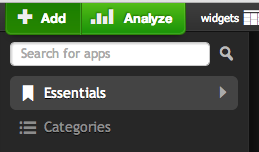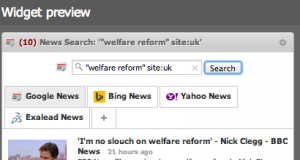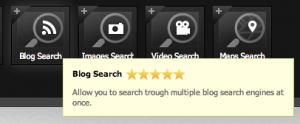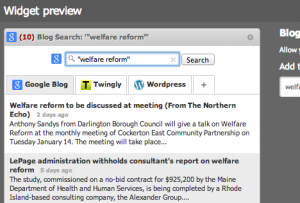Earlier this week we published our list of 19 places to follow welfare developments. In the first of a three-part series, we explain how to get your own list of useful feeds into one page, and share it with others.
Step 1: Use a ‘personalisable homepage’ news reader like Netvibes or Feedly
There are a number of services that allow you to follow multiple sources of news at the same time – often called ‘news readers’ or ‘RSS readers’. I used Netvibes for compile this list, because you can share those lists with other people, but you may have another preference (Feedly and Flipboard are also nice, but currently don’t have the same option). The video below is just one of many providing an introduction to Netvibes:
Follow the instructions above on creating an account with Netvibes and adding feeds.
If you want your feeds page to be seen by others
If you want your feeds to be public, however, you’ll need to enable the public dashboard first. To do this:
- Click on the Dashboards menu at the top of the page.
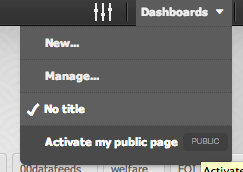
- Then select Activate my public page at the bottom of that menu -this kicks off the process of turning that public page on.
- On the page that appears tick ‘Enable‘ next to the Your public page box (see image right).
 And click Save changes.
And click Save changes. - You may be prompted to add some further profile details, such as your age
 (public pages can only be created by users above a certain age). Do this by clicking on profile in the prompt, Save changes, then return to the page where you can enable a public dashboard.
(public pages can only be created by users above a certain age). Do this by clicking on profile in the prompt, Save changes, then return to the page where you can enable a public dashboard. - Once you’ve completed this process, your public page can now be accessed from the same place on the Dashboards menu. Make sure you are on your public page before you begin adding feeds.
Then the real work begins
Step 2: Feeds for context: finding news sources on welfare
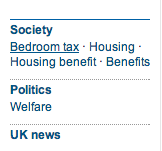
Our first tab in Netvibes is for general welfare news. There might be some that you already know: The Guardian, for example, has a specific section on housing, with its own RSS feed, and you can even find a page for all articles involving the topic ‘benefits’ (look out for the topics listed to the right of every article – see image left).
Specific journalists on the site also have feeds – here’s Shiv Malik, for example.
Aside from The Guardian, however, you’d be hard pressed to find many reporters or sections devoted to welfare issues. So here’s a useful trick:
Click on the ‘Add‘ button in the upper left corner, and select the ‘Essentials‘ option.
Click on the ‘News search‘ button.
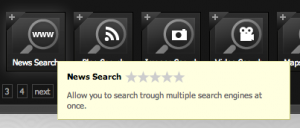
You’ll get a ‘widget preview’ which allows you to specify the search you want to make.
This should have two parts:
- A key phrase which should only appear in welfare-related stories. The word benefit alone, for example, is going to be too broad, so think of phrases like “bedroom tax” or “welfare reform”. Put them in quotation marks, otherwise, the search will include those two words when they’re not together. (You can adapt this to get results by a particular journalist by using their name instead of the phrase)
- site:uk – this search operator ensures that you will only get results from .uk websites. Note that there’s no space after the colon. If you only want results from a particular newspaper, you can adapt this to something like site:telegraph.co.uk
The image above shows an example. When you’re happy with the results, click the green + icon and it should be added to your dashboard.
Specialist sources
It’s easy to overlook specialist sources on welfare news: Inside Housing, for example, or publications covering the voluntary sector like Third Force News.
Thinking about specific issues like housing, child poverty or unemployment will make it easier to find these. That will also help with the next category: blogs.
Official sources
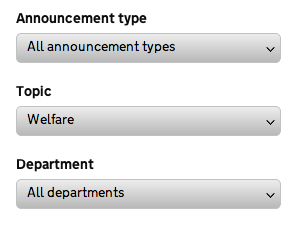 Gov.uk’s announcements page offers feeds or alerts for press releases, ‘news stories’ and speeches from a range of government departments (you can select ‘Welfare’ from the topics menu).
Gov.uk’s announcements page offers feeds or alerts for press releases, ‘news stories’ and speeches from a range of government departments (you can select ‘Welfare’ from the topics menu).
Your local authority and public bodies’ press offices may offer similar facilities.
Step 3: Context and case studies: the blogs
A search on Google for “child poverty blog” brings up a range of results from The Children’s Society blog posts on the topic to the North East Child Poverty Commission, the London School of Economics, and the Joseph Rowntree Foundation blog.
Some of these results will include organisations and individuals who blog regularly on social issues – and add those to your dashboard.
But there will also be some sources who only do so occasionally. For those you can use Netvibes’ blog search button – next to the news search option explained above.
As most blogs are hosted on .com domains (such as wordpress.com or blogspot.com) the site:uk operator will exclude too many relevant results, so for this search stick to a specific phrase. “Welfare reform” will include US results, for example (maybe not too many to be annoying) but “bedroom tax” and “universal credit” are UK-specific.
You can also try adding local place names like “York” or “Birmingham” (in the latter case also add -Alabama to exclude any results from the US city).
Blogs without feeds
In some cases you will find blogs which Netvibes cannot detect an RSS feed for. The Children’s Society blog, for example, doesn’t appear to have one.
For these you could use a service like HTML2RSS, which looks for changes in a webpage and creates an RSS feed alert whenever that page changes. If there’s an email alert you can also use an email-to-RSS service (Google and try a few).
Or you could just ask them on Twitter (The Children’s Society replied saying that theirs is here)
Blogrolls
Blogrolls are lists of links to similar or favourite blogs that often appear on the right hand column of a site (you may have to scroll down).
The Benefit Scrounging Scum blog, for example, includes separate blogrolls for ‘Bendy bloggers’ ‘Blogging buddies and regular reads’ and ‘Medical experts’

Looking for and following these links can lead you to other sources you might not otherwise find.
Step 4: Start to organise things
At this point – or before you even start – you might want to consider splitting your Netvibes dashboard into more than one section (tab). For example, some of your news sources might be about welfare issues in general, whereas others may be specific to particular policies or debates.
You will probably want to separate campaign-based sources from news reporting, too, given that the reporting normally provides the wider context while the campaigns are likely to be sources of leads on events and other developments.
In the next two parts we will add even more sections: wider discussion, for example – what people are talking about on social media, including case studies who might have their own personal experiences to share. And data and documents: what public bodies are disclosing – willingly or reluctantly.
